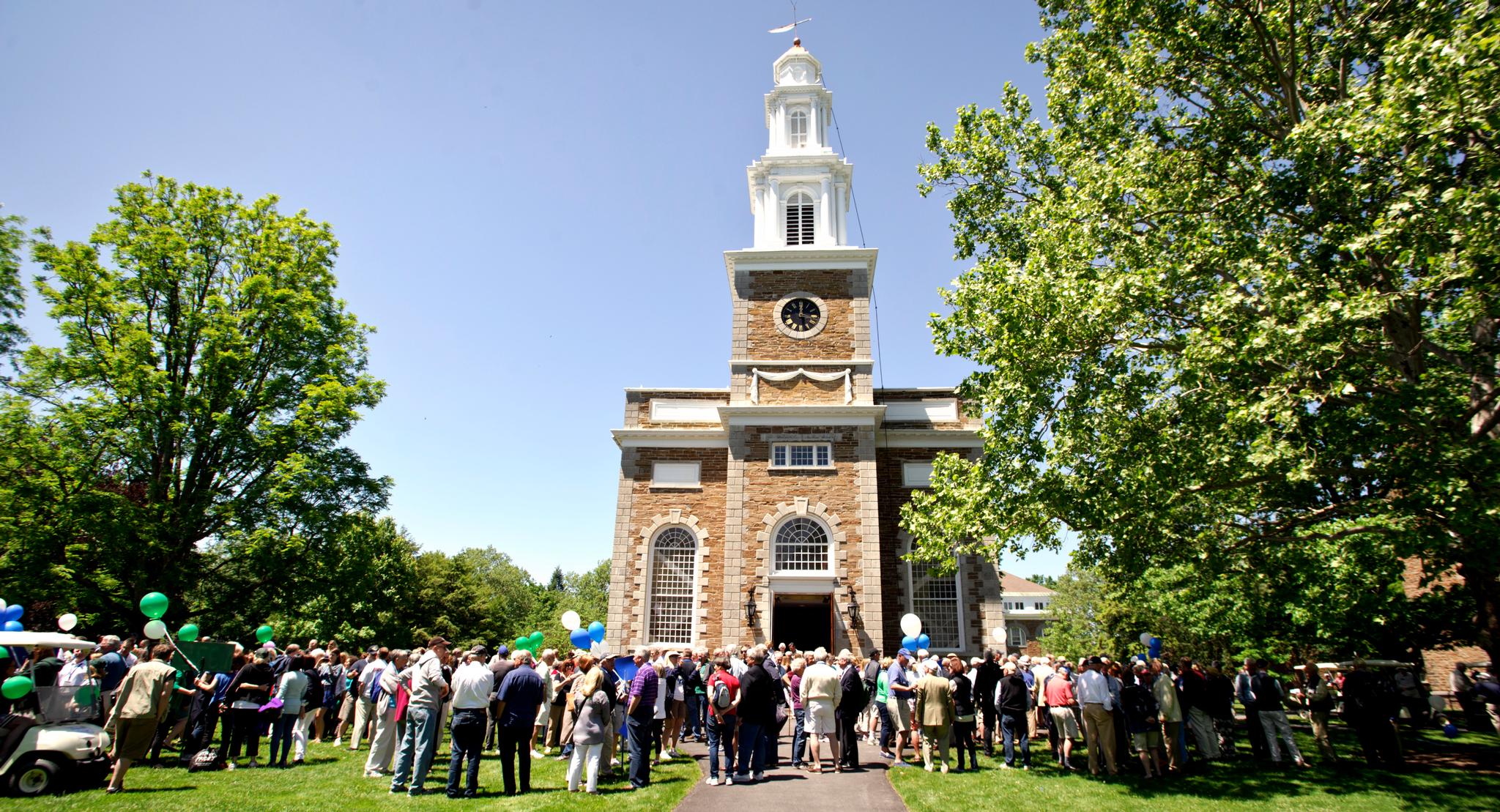
Love Thy Neighbor:
Religious Space at a Secular Institution
By: Jonathan Nemetz

Welcome to the Hamilton Chapel!
The Chapel is notable for its three different floors, as opposed to most Federal Style chapels which have just two, a sanctuary and a balcony level. This unique design was meant to provide a third floor College Library, as well as a classroom space for studies of Theology and World Religions. However, it now provides the Chapel with a unique extra space that can serve different functions, while still retaining a historic sanctuary and an iconic and recognizable Chapel exterior.
The Chapel is an ever-evolving building, and the product of a history of different visions for the purpose of a College Chapel.
Listen to a podcast on the on the three approaches modern Chapels take to serving their community. Listen for the difference in acoustics between the three distinct locations.
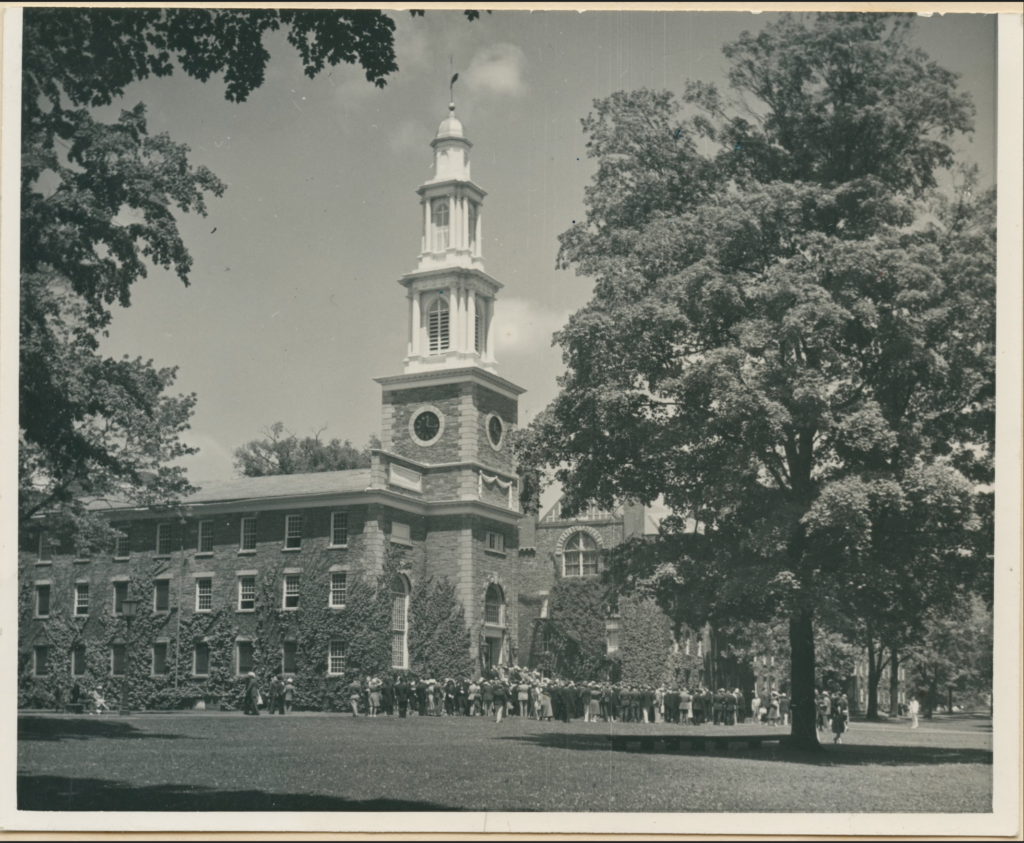
The three different floors of the Chapel all have something to say about the role of religious spaces on modern college campuses. They represent different uses, but each function and vision of the Chapel meshes to create a space for inclusive spiritual community.
Commencement was held in the Chapel when Hamilton’s class sizes were a little smaller. Click on the image to learn more about the Chapel’s various uses. Photograph, 1940

1827
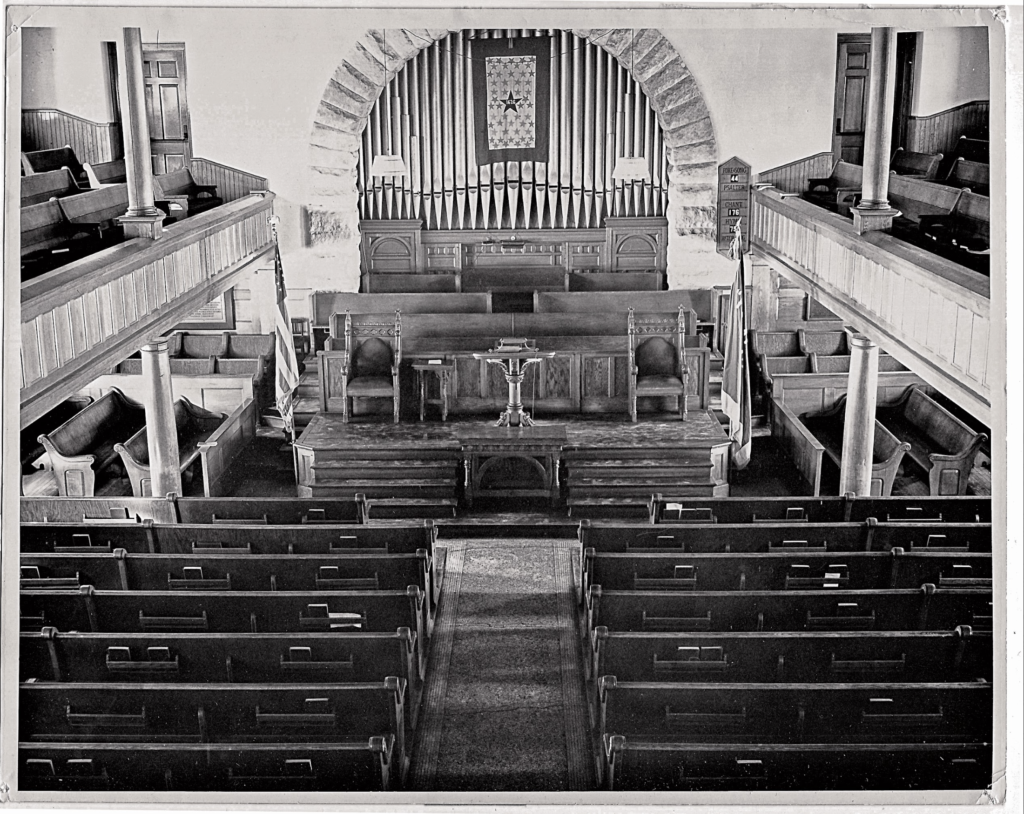
Late 1800s

1949
The sanctuary has undergone a series of renovations which have all tried to capture a sense of history and traditionalism in an ever changing campus, and an ever changing sense of where Hamilton’s legacy begins. The first sanctuary was simple to harken back to Samuel Kirklands background as a missionary in simple one room churches, while the second renovation looked to connect the church to the history of mainline Protestant Christianity (in opposition to the revivalist movements of the 1800s) with what was considered a more Victorian look. In 1949, much of these elements were removed to try and recapture the, already apocryphal, look of the early 1800s. Which of the styles depicted here is truly ‘traditional’ or ‘authentic’? The story that we tell with our historic buildings is ever changing as the goals and identity of the college change, even if, ironically, part of that new story is of continuity to the past.
(Top Left) Photograph of Original Chapel Interior, Unknown Date. (Center) Postcard of ‘Victorian’ Interior, Unknown Date. (Top Right) Photograph Following Renovations, 1949. (Bottom Right) Promotional Photograph from Hamilton’s Website, 2017.
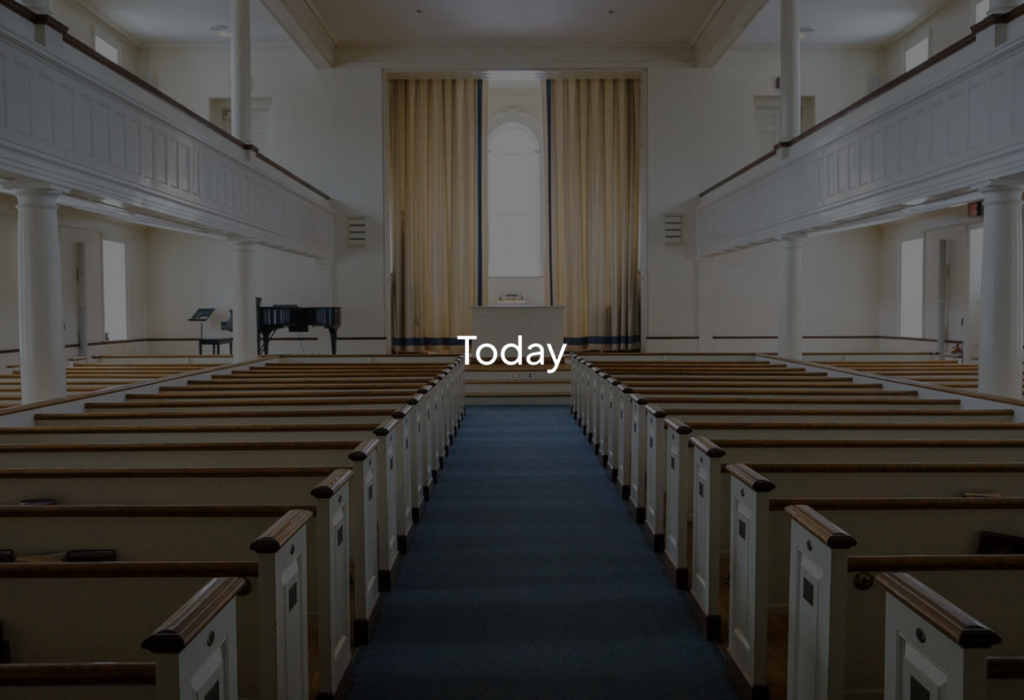
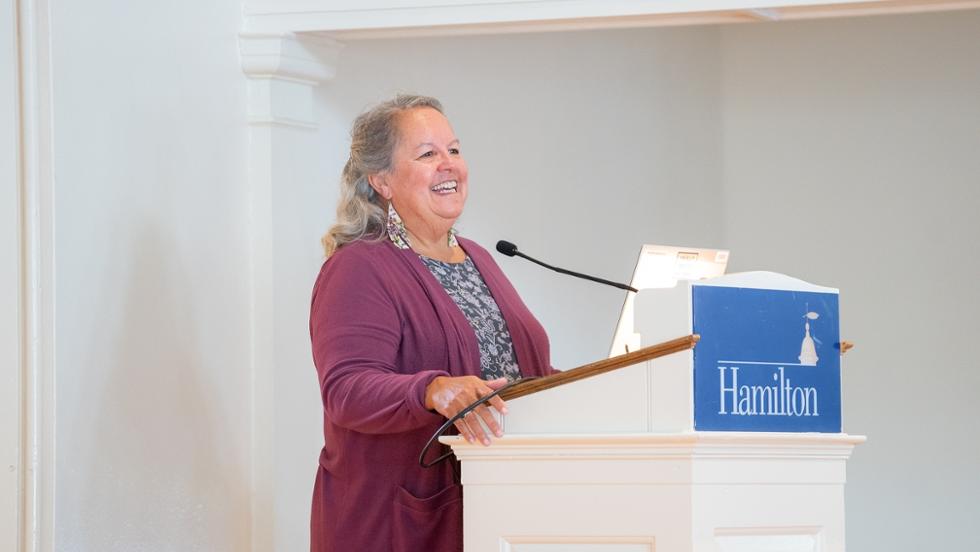
The Chapel sanctuary today is able to act as a versatile space for secular events, hosting speakers like author Robin Wall Kimmerer, as well as panels and discussions in a historic setting. Before such professional speakers were billed, Hamilton students would recite speeches by memory from the lectern pictured above to the whole school as the culmination of public speaking courses. Photo by Zach Stanek, September 25, 2023.
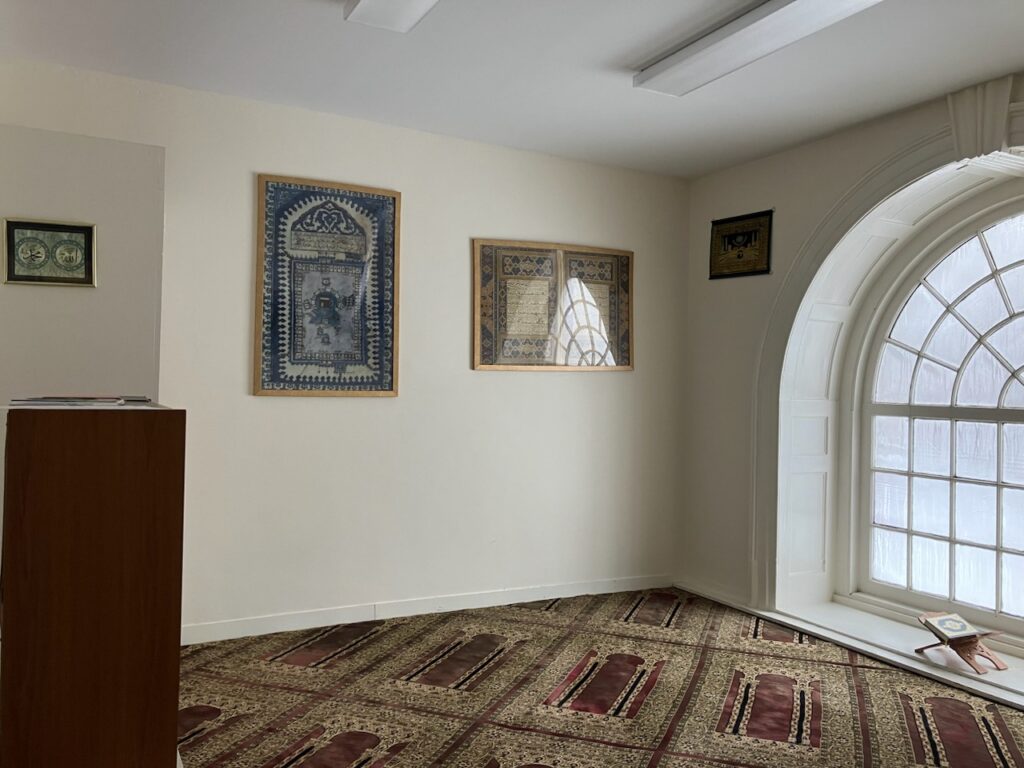
This is the Chapel’s Muslim prayer room, part of the 1999 renovation’s goal to have more distinct religious spaces. Not only is the room more decorated, but people are not allowed to study or hold non-prayer related events here, as opposed to the more versatile but open lounge area. In addition to the Muslim prayer room, the Azel Backus House was expanded as a space exclusively for Hillel and the Jewish Chaplaincy. Both of these spaces make students more comfortable expressing a non-Christian faith, but also separates out students, and makes the Chapel sanctuary and lounge a less universally important space.
Photograph of 2nd Floor Muslim Prayer Room, taken by myself, 2023. The window (when not frosted) looks out over the Mohawk Valley and a statue of Alexander Hamilton. Luckily, the Chapel is already oriented east, the traditional direction for Muslim prayer, so students may face towards the window while praying.
The Chapel lounge represents a more versatile but non-descript approach to College Chapels. Its small library covers a range of topics on the history of religions, theology of various faiths, and secular philosophy and mindfulness texts. This has made the space a popular spot for interfaith and mindfulness activities on campus, due to its cozy living room feel and lack of attachment to one religious tradition.The lounge is a collective gathering space, and the offices of so many campus spiritual leaders coming and going on the third floor increase these interactions. Although recent faculty departures have lessened the effectiveness of this design.
Photo by Hamilton Chaplaincy of Lounge and Chaplain Jeff McArn, Date Unknown. Casual discussions like this are a product of the third floor’s status as a nexus of activity.
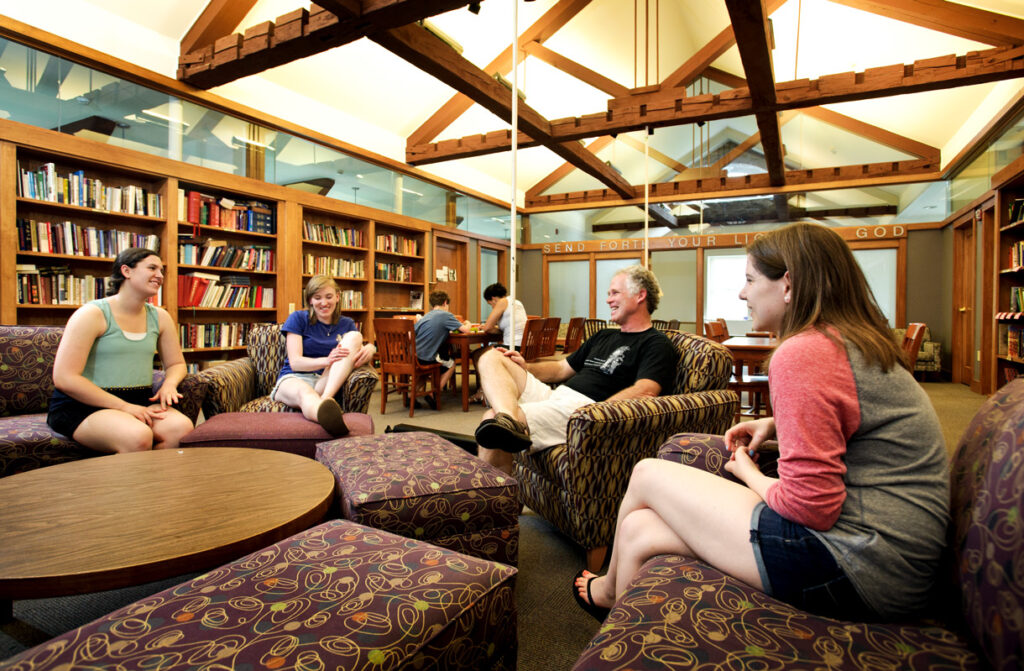
…students were uncomfortable with a multipurpose Chapel because it diluted the difference between faiths
Madeline Carlman’s 2017 Senior Thesis on the left includes a number of student testimonials about their religious experience at Hamilton. A few discuss the Chapel and some of its organizations as representative or not representative of their faith. Some testimonials push back on the value of a multipurpose space, others appreciate it, and feel that certain campus organizations are too focused on making a monotheistic space.
These testimonials begin on page 35.
(Carlman, 2017, pg. 26)
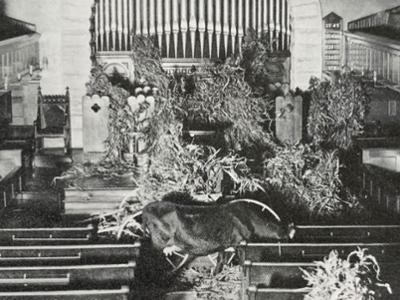
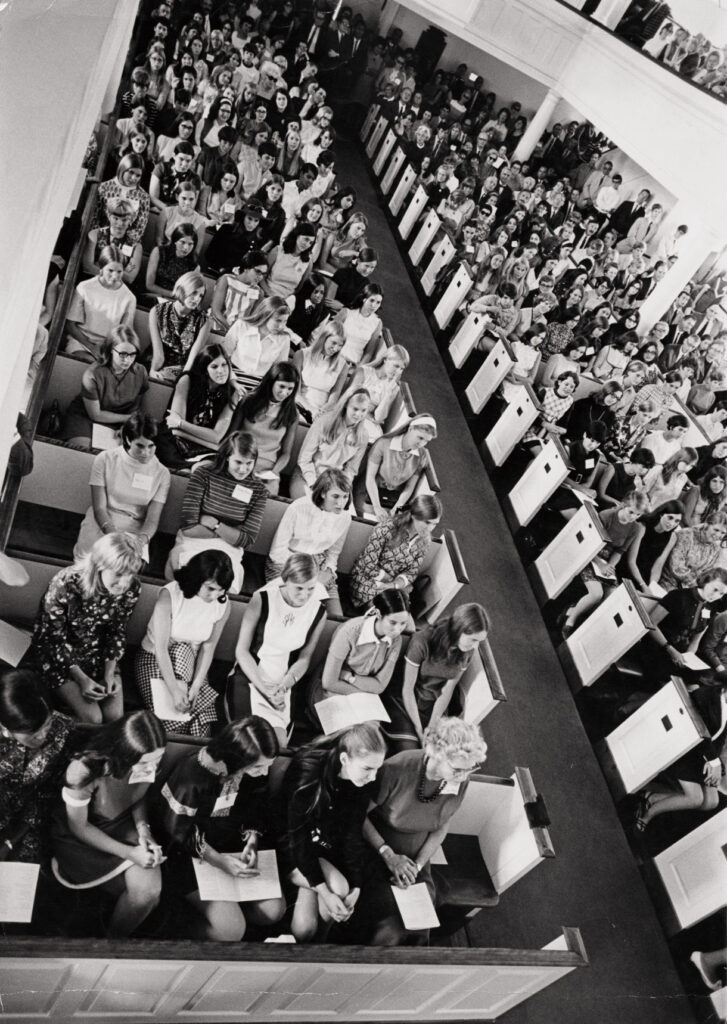
The Chapel hosts a number of groups like the Shenandoah-Kirkland Initiative (SKI) that have brought students of religious and non-religious backgrounds together. Such programs have helped the Chapel develop a reputation as a tolerant and progressive place on campus among a student body that may be more skeptical of religious institutions.
Learn more about SKI at the Chapel here.
Photo by Shenandoah-Kirkland Initiative, 2018

The Chaplaincy is built around the notion of bringing people together: people who share a particular faith commitment, and people looking for community.
From “Rationale for Chaplaincy’s Use of the Third Floor”, outlining wishes before the 1999 renovations

damage the more historic brick facade of the Chapel.

A letter from Hamilton’s most recent Chaplain, Jeff McArn to students, as a part of the Chapel’s switch to being open 24/7 in 2008. Ultimately, the message is that the Chapel is for everyone, and for any activity (within respectful boundaries). It is a space unlike any other on campus, in whatever form it takes.
Where ya gonna go? The Chapel.
Works Cited
“1999 Renovation Designs & Proposals”, 1999, Chapel Renovations, Hamilton College Archives, Clinton, NY.
“Bicentennial Celebration Photograph”, 2017, Chapel, Hamilton College Archives, Clinton, NY.
Boucher, Kateri, and Jaime Kucinskas. “‘Too Smart to Be Religious?’ Discreet Seeking Amidst Religious Stigma at an Elite College.” Social Inclusion 4, no. 2 (April 19, 2016): 40–51. https://doi.org/10.17645/si.v4i2.491.
Carlman, Madeline. “Living off a Prayer: Explanations of Spiritual and
Religious Transformation at Hamilton College” Undergraduate Thesis, Hamilton College, 2017. Sociology 5-2017
“Chapel Survey Sketches”, 1928, Chapel, Hamilton College Archives, Clinton, NY.
Chop, Rebecca S., et al. “The Spiritual Life of College Students” UCLA, Higher Education Research Institute, 2004
Forster-Smith, Lucy A. College & University Chaplaincy in the 21st Century: A Multifaith Look at the Practice of Ministry on Campuses Across America. Skylight Paths Publishing, 2013.
Hamilton College. “Finding Common Ground at Hamilton,” December 12, 2023. https://www.youtube.com/watch?v=GhW6izWvQV8.
Hamilton College. “‘New’ Hamilton College Chapel Unveiled,” November 18, 2021. https://www.youtube.com/watch?v=KvYYVTrEV5I.
Hamilton Magazine. “Thirteen Ways of Looking at the Chapel – Hamilton College,” Summer 2009 https://www.hamilton.edu/magazine/summer09/thirteen-ways-of-looking-at-the-chapel.
“Newspaper Clip written by Jeff McArn on Chapel’s 24/7 opening” 2008, Chapel, Hamilton College Archives, Clinton, NY.
“Old Interior Post Card”, 1800s, Chapel, Hamilton College Archives, Clinton, NY.
“Photograph from Back of Chapel”, 1960, Chapel, Hamilton College Archives, Clinton, NY.
“Rationale for Chaplaincy Use of Space Third Floor, Chapel”, 1998, Chapel Renovations, Hamilton College Archives, Clinton, NY.
“Renovated Interior Post Card”, 1949 or Later, Chapel, Hamilton College Archives, Clinton, NY.
Santomauro-Stenzel, Eric. “College Rebrands Chaplaincy ‘Spiritual and Religious Life,’ Faculty to Vote on McArn Motion.” The Monitor (blog), August 30, 2023. https://www.hamiltonmonitor.com/post/college-rebrands-chaplaincy-spiritual-and-religious-life-faculty-to-vote-on-mcarn-motion.
Santomauro-Stenzel, Eric. “Two Hamilton Chaplaincy Staff Resign In Protest While College Digs In.” The Monitor (blog), July 29, 2023. https://www.hamiltonmonitor.com/post/two-hamilton-chaplaincy-staff-resign-in-protest-while-college-digs-in.
The Editors of Encyclopaedia Britannica. “Samuel Kirkland | Missionary, Educator, Diplomat.” Encyclopedia Britannica, November 27, 2023. https://www.britannica.com/biography/Samuel-Kirkland.
The Survey Center on American Life. “Generation Z and the Future of Faith in America – The Survey Center on American Life,” March 31, 2023. https://www.americansurveycenter.org/research/generation-z-future-of-faith/.
“Victorian Interior Post Card”, 1800s, Chapel, Hamilton College Archives, Clinton, NY.
Wuthnow, Robert. America and the Challenges of Religious Diversity. Princeton University Press, 2011.